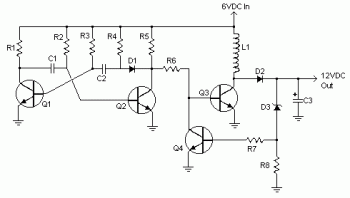This is the circuit diagram of 6VDC to 12VDC Converter. With this circuit, you can doubled the input voltage of 6V DC to become 12V DC output voltage.
Component Parts:
Circuit Notes:
1. L1 is a custom inductor wound with about 80 turns of 0.5mm magnet wire around a toroidal core with a 40mm outside diameter.
2. Different values of D3 can be used to get different output voltages from about 0.6V to around 30V. Note that at higher voltages the circuit might not perform as well and may not produce as much current. You may also need to use a larger C3 for higher voltages and/or higher currents.
3. You can use a larger value for capacitor C3 to provide better filtering.
4. The circuit will require about 2A from the 6V supply to provide the full 800mA at 12V.
6VDC to 12VDV Converter circuit, source:
http://www.high-voltage-lab.com/61/6v-to-12v-converter
Component Parts:
| R1, R4 = 2.2K R2, R3 = 4.7K R5 = 1K R6 = 1.5K R7 = 33K R8 = 10K C1,C2 = 0.1uF | C3 = 470uF/25V D1 = 1N914 D2 = 1N4004 D3 = 12V 400mW Zener Diode Q1, Q2, Q4 = BC547 Q3 = BD679 L1 See Notes |
Circuit Notes:
1. L1 is a custom inductor wound with about 80 turns of 0.5mm magnet wire around a toroidal core with a 40mm outside diameter.
2. Different values of D3 can be used to get different output voltages from about 0.6V to around 30V. Note that at higher voltages the circuit might not perform as well and may not produce as much current. You may also need to use a larger C3 for higher voltages and/or higher currents.
3. You can use a larger value for capacitor C3 to provide better filtering.
4. The circuit will require about 2A from the 6V supply to provide the full 800mA at 12V.
6VDC to 12VDV Converter circuit, source:
http://www.high-voltage-lab.com/61/6v-to-12v-converter

Comments
power supply
I am trying to find ways to reduse the bateries to 4 X 1.5v = 6v and stepup to 12v to power the same 4 LEDs with out using resistors.
Any ideas that simple plan and parts which I can get easily from electronic shops?